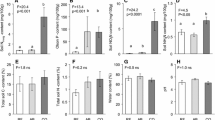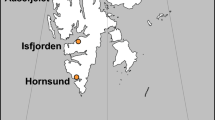Abstract
This study investigated the effects of cormorant colonies on plant–arthropod island food webs, the consequences of nutrient-rich runoff on marine communities, and feedback loops from marine to terrestrial ecosystems. Terrestrial plant responses were as expected, with the highest plant biomass on islands with low nest density and the highest nitrogen (N) content on islands with high nest density. In contrast to our hypothesis, we found no uniform density response across guilds. Among herbivores, the variable responses may depend on the relative importance of plant quality or quantity. As expected, nutrient-rich runoff entered water bodies surrounding cormorant nesting islands, but only at high nest density, and increased the density of emerging insects. This created a potential feed-back loop to spiders (major terrestrial predators), where stable isotope analyses suggested great use of chironomids. Contrary to our expectation, this potential feed-back did not result in the highest spider density on islands with a high cormorant nest density. Web spiders showed no changes in density on active cormorant islands, and lycosids were actually less abundant on active cormorant islands compared to reference islands. The variable response of spiders despite increased dipteran densities, and also in other consumer groups, may be due to direct negative effects of cormorants on soil chemistry, vegetation cover, and other density regulating forces (for example, top–down forces) not studied here. This study highlights the importance of including processes in the surrounding marine ecosystem to understand the impacts of seabirds on the food web structures of their nesting islands.






Similar content being viewed by others
References
Anderson WB, Polis GA. 1999. Nutrient fluxes from water to land: seabirds affect plant nutrient status on Gulf of California islands. Oecologia 118:324–32.
Awmack CA, Leather SR. 2002. Host plant quality and fecundity in herbivorous insects. Annu Rev Entomology 47:817–44.
Barrett K, Anderson WB, Wait DA, Grismer LL, Polis GA, Rose MD. 2005. Marine subsidies alter the diet and abundance of insular and coastal lizard populations. Oikos 109:145–53.
Borer ET, Seabloom EW, Shurin JB, Anderson KE, Blanchette CA, Broitman B, Cooper SD, Halpern BS. 2005. What determines the strength of a trophic cascade? Ecology 86:528–37.
Bosman AL, Hockey PAR. 1988. The influence of seabird guano on the biological structure of rocky intertidal communities on islands off the west coast of southern Africa. S Afr J Mar Sci 7:61–8.
Bosman AL, Du Toit JT, Hockey PAR, Branch GM. 1986. A filed experiment demonstrating the influence of seabird guano on intertidal primary production. Estuar Coast Shelf Sci 23:283–94.
Boyer AG, Swearingen RE, Blaha MA, Fortson CT, Gremillion SK, Osborn KA, Moran MD. 2003. Seasonal variation in top-down and bottom-up processes in a grassland arthropod community. Oecologia 136:309–16.
Chan EKW, Zhang Y, Dudgeon D. 2009. Substrate availability may be more important than aquatic insect abundance in the distribution of riparian orb-web spiders in the tropics. Biotropica 41:196–201.
Ellis JC. 2005. Marine birds on land: a review of plant biomass, species richness, and community composition in seabird colonies. Plant Ecol 181:227–41.
Ellis JC, Farina JM, Witman JD. 2006. Nutrient transfer from sea to land: the case of gulls and cormorants in the Gulf of Maine. J Anim Ecol 75:565–74.
Elser JJ, Matthew MES, Cleland EE, Gruner DS, Harpole WS, Hillebrand H, Ngai JT, Seabloom EW, Shurin JB, Smith JE. 2007. Global analysis of nitrogen and phosphorus limitation of primary producers in freshwater, marine and terrestrial ecosystems. Ecol Lett 10:1135–42.
Ericson L, Wallentinus HG. 1977. Sea-shore vegetation around the Gulf of Bothina. Wahlenbergia 5:3–118.
Fukami T, Wardle DA, Bellingham PJ, Mulder CPH, Towns DR, Yeates GW, Bonner KI, Durrett MS, Grant-Hoffman MN, Williamson WM. 2006. Above- and below-ground impacts of introduced predators in seabird-dominated island ecosystems. Ecol Lett 9:1299–307.
Graham AK, Buddle CM, Spence JR. 2003. Habitat affinities of spiders living near a freshwater pond. J Arachnol 31:78–89.
Gratton C, Donaldson J, Vander Zanden MJ. 2008. Ecosystem linkages between lakes and surrounding terrestrial landscape in northeast Iceland. Ecosystems 11:764–74.
Haddad NM, Haarstad J, Tilman D. 2000. The effects of long-term nitrogen loading on grassland insect communities. Oecologia 124:73–84.
Hairstone NG, Frederick ES, Slobodkin LB. 1960. Community structure, population reference and competition. Am Nat 94:421–5.
Halaj J, Wise DH. 2002. Impact of a detrital subsidy on trophic cascades in a terrestrial grazing food web. Ecology 83:3141–51.
Huberty AF, Denno RF. 2006. Consequences of nitrogen and phosphorus limitation for the performance of two planthoppers with divergent life-history strategies. Oecologia 149:444–55.
Hunter MD, Price PW. 1992. Playing chutes and ladders–heterogeneity and the relative roles of bottom-up and top-down forces in natural communities. Ecology 73:724–32.
Hyodo F, Wardle DA. 2009. Effect of ecosystem retrogression on stable nitrogen and carbon isotopes of plants, soils and consumer organisms in boreal forest islands. Rapid Commun Mass Spectrom 23:1892–8.
Jacobs W. 1998. Biologie und Ökologie der Insekten: ein Tschenlexikon, 3rd edn. In: Honomichl K, Ed. Stuttgard: Gustav Fischer Verlag.
Jonsson M, Wardle AD. 2009. The influence of freshwater-lake subsidies on invertebrates occupying terrestrial vegetation. Acta Oecologica 35:698–704.
Länsstyrelsen. 2005. Kända mellanskarvskolonier i Stockholms skärgård i ab län.
Lindeboom HJ. 1984. The nitrogen pathway in a penguin rookery. Ecology 65:269–77.
Löfgren A, Jerling L. 2002. Species richness, extinction and immigration rates of vascular plants on islands in the Stockholm Archipelago, Sweden, during a century of ceasing management. Folia Geobotanica 37:297–308.
Mattson WJ. 1980. Herbivory in relation to plant nitrogen-content. Annu Rev Ecol Syst 11:119–61.
Markwell TJ, Daugherty CH. 2002. Invertebrate and lizard abundance is greater on seabird-inhabited islands than on seabird-free islands in the Marlborough Sounds, New Zealand. Écoscience 9:293–9.
McCutchan JH, Lewis WM, Kendall C, McGrath CC. 2003. Variation in trophic shift for stable isotope ratios of carbon, nitrogen, and sulfur. Oikos 102:378–90.
Miyashita T, Takada M. 2007. Habitat provisioning for aboveground predators decreases detritivores. Ecology 88:2803–9.
Mulder CPH, Keall SN. 2001. Burrowing seabirds and reptiles: impacts on seeds, seedlings and soils in an island forest in New Zealand. Oecologia 127:350–60.
Oksanen L, Fretwell SD, Arruda J, Niemela P. 1981. Exploitation ecosystems in gradient of primary productivity. Am Nat 118:240–61.
Onuf CP, Teal JM, Valiela I. 1977. Interactions of nutrients, plant growth and herbivory in a mangrove ecosystem. Ecology 58:514–26.
Orgeas J, Vidal E, Ponel P. 2003. Colonial seabirds change beetle assemblages on a Mediterranean island. Écoscience 10:38–44.
Pace ML, Cole JJ, Carpenter SR, Kitchell JF. 1999. Trophic cascades revealed in diverse ecosystems. Trends Ecol Evol 14:483–8.
Palomo G, Iribarne O, Martinez MM. 1999. The effects of migratory seabirds guano on the soft bottom community of SW Atlantic coastal lagoon. Bull Mar Sci 65:119–28.
Pennington JT, Mahoney KL, Kuwahara VS, Kolber DD, Calienes R, Chavez FP. 2006. Primary production in the eastern tropical Pacific: a review. Prog Oceanogr 69:285–317.
Phillips DL, Gregg JW. 2001. Uncertainty in source partitioning using stable isotopes. Oecologia 127:171–9.
Pinnegar JK, Polunin NVC. 1999. Differential fractionation of δC13 and δ N15 among fish tissues: implications for the study of trophic interactions. Funct Ecol 13:225–31.
Polis GA, Hurd SD. 1995. Extraordinarily high spider densities on islands—flow of energy from the marine to terrestrial food webs and the absence of predation. Proc Natl Acad Sci USA 92:4382–6.
Polis GA, Sanchez-Pinero F, Stapp PT, Anderson WB, Rose MR. 2004. Trophic flows from water to land: marine input affects food webs of island and costal ecosystems worldwide. In: Polis GA, Power ME, Huxel GR, Eds. Food webs—at the landescape level. Chicago and London: The University of Chicago Press. pp 201–16.
Post DM, Layman CA, Arrington DA, Takimoto G, Quattrochi J, Montana CG. 2007. Getting to the fat of the matter: models, methods and assumptions for dealing with lipids in stable isotope analyses. Oecologia 152:179–89.
Raschmanová N, Kováč L, Miklisová D. 2008. The effect of mesoclimate on Collembola diversity in the Zádiel Valley, Slovak Karst (Slovakia). Eur J Soil Biol 44:463–72.
Råberg S, Kautsky L. 2008. Grazer identity is crucial for facilitating growth of the perennial brown alga Fucus vesiculosus. Mar Ecol Prog Ser 361:111–18.
Sánchez-Piñero F, Polis GA. 2000. Bottom-up dynamics of allochthonous input: direct and indirect effects of seabirds on islands. Ecology 81:3117–32.
Sanzone DM, Meyer JL, Marti E, Gardiner EP, Tank JL, Grimm NB. 2003. Carbon and nitrogen transfer from a desert stream to riparian predators. Oecologia 134:238–50.
Siemann E. 1998. Experimental tests of effects of plant productivity and diversity on grassland arthropod diversity. Ecology 79:2057–70.
Sotiropoulos MA, Tonn WM, Wassenaar LI. 2004. Effects of lipid extraction on stable carbon and nitrogen isotope analyses of fish tissues: potential consequences for food web studies. Ecol Freshw Fish 13:155–60.
Staav R. 2008. Skarv. In: Standfager K, Palmblad U, Eds. Levande skärgårdsnatur 2008—med rapporter från 2007. Stockholm: Skärgårdsstiftelsen (in swedish).
Stadler B, Michalzik B. 1998. Linking aphid honeydew, throughfall, and forest floor solution chemistry of Norway spruce. Ecol Lett 1:13–16.
Stapp P, Polis GA. 2003. Marine resources subsidize insular rodent populations in the Gulf of California, Mexico. Oecologia 134:496–504.
Towns DR, Wardle DA, Mulder CPH, Yeates GW, Fitzgerald BM, Parrish GR, Bellingham PJ, Bonner KI. 2009. Predation of seabirds by invasive rats: multiple indirect consequences for invertebrate communities. Oikos 118:420–30.
Vanderklift MA, Ponsard S. 2003. Sources of variation in consumer-diet δN15 enrichment: a meta-analysis. Oecologia 136:169–82.
Vitousek PM, Howarth RW. 1991. Nitrogen limitation on land and in the sea—how can it occur? Biogeochemistry 13:87–115.
Wainright SC, Haney JC, Kerr C, Golovkin AN, Flint MV. 1998. Utilization of nitrogen derived from seabird guano by terrestrial and marine plants at St. Paul, Pribilof Islands, Bering Sea, Alaska. Mar Biol 131:63–71.
Wait DA, Aubrey DP, Anderson WB. 2005. Seabird guano influences on desert islands: soil chemistry and herbaceous species richness and productivity. J Arid Environ 60:681–95.
Wardle DA, Bellingham PJ, Bonner KI, Mulder CPH. 2009. Indirect effects of invasive predators on litter decomposition and nutrient resorption on seabird-dominated islands. Ecology 90:452–62.
Wolf N, Carleton SA, Martinez del Rio C. 2009. Ten years of experimental animal isotopic ecology. Funct Ecol 23:17–26.
Wolfe KM, Mills HR, Garkaklis MJ, Bencini R. 2004. Post-mating survival in a small marsupial is associated with nutrient inputs from seabirds. Ecology 85:1740–6.
Wootton JT. 1991. Direct and indirect effects of nutrients on intertidal community structure—variable consequences of seabird guano. J Exp Mar Biol Ecol 151:139–53.
Worm B, Lotze HK, Sommer U. 2000. Coastal food web structure, carbon storage, and nitrogen retention regulated by consumer pressure and nutrient loading. Limnol Oceanogr 45:339–49.
Xu GL, Schleppi P, Li MH, Fu SL. 2009. Negative response of Collembola in a forest soil (Alptal, Switzerland) under experimentally increased N deposition. Environ Pollut 157:2030–6.
Acknowledgements
We gratefully acknowledge the assistance of H. Axemar, M. Enskog, B. Jerling, E. Jerling, and S. Jerling—in the field and in the lab; H.-E. Wanntorp and C.-C Coulianos for help in identifying beetle and bug species; and T. Primack and two anonymous reviewers for providing helpful suggestions. Isotopic ratios were measured in the UC Davis Stable Isotope facility, California, USA. Funding was provided by the Swedish Research Council Formas (to PAH).
Author information
Authors and Affiliations
Corresponding author
Additional information
Author Contributions
GK was involved in all parts of the study, JE was involved in the field parts, PAH was involved in the design and analysis of the study and in the writing of the text.
Electronic supplementary material
Below is the link to the electronic supplementary material.
Rights and permissions
About this article
Cite this article
Kolb, G.S., Jerling, L. & Hambäck, P.A. The Impact of Cormorants on Plant–Arthropod Food Webs on Their Nesting Islands. Ecosystems 13, 353–366 (2010). https://doi.org/10.1007/s10021-010-9323-8
Received:
Accepted:
Published:
Issue Date:
DOI: https://doi.org/10.1007/s10021-010-9323-8




